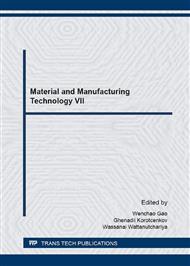p.133
p.138
p.147
p.152
p.157
p.162
p.168
p.175
p.181
Preparation and Characterization of Bionanocomposite Films Made from Carrageenan, Beeswax and ZnO Nanoparticles
Abstract:
The objective of this study was to develop biopolymer based films as alternative of synthetic petroleum based-packaging. The ZnO NPs (0.5 and 1% w/w carrageenan) and beeswax (3% v/v), as hydrophobic component, were incorporated into carrageenan polymer to produced bionanocomposite films. The resulting films were characterized using SEM. The physical and mechanical properties of films were also investigated. The addition of ZnO NPs and beeswax resulted in different morphological surface as well as influenced the surface color of carrageenan film. Incorporation of ZnO NPs increased TS and EAB of the film, while WVTR decreased. Furthermore, the presence of beeswax within the carrageenan and or its nanocomposite films promoted synergistic effect with ZnO NPs in reducing WVTR and EAB, however decreased TS of films. Therefore, these bionanocomposite films were potentially used in packaging industry to maintain the quality of food stuffs.
Info:
Periodical:
Pages:
157-161
Citation:
Online since:
September 2016
Keywords:
Price:
Сopyright:
© 2016 Trans Tech Publications Ltd. All Rights Reserved
Share:
Citation:


